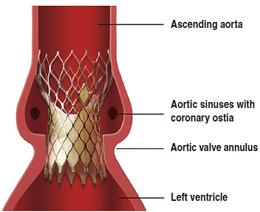
HLT has announced first patient implants in a feasibility clinical study to assess the safety and performance outcomes of its Meridian Transcatheter Aortic Valve and Pathfinder II Delivery System in patients with severe aortic stenosis at high risk for surgery.
The implants were completed at Quebec Heart and Lung Institute in Quebec City, Canada, by Josep Rodés-Cabau, M.D., and his team
"The Meridian Valve allows us to evaluate complete valve function before releasing it from the delivery system," said Dr. Rodés-Cabau, director of Catheterization and Interventional Laboratories at the Quebec Heart and Lung Institute (Quebec City, Quebec, Canada). "The valve was easy to implant and the overall procedure was predictable. Hemodynamic stability was maintained throughout the entire procedure, including the time of valve implant."
The RADIANT trial is a prospective, non-randomized, single-arm, multicenter study that will enroll up to 20 high-risk patients with severe aortic valve stenosis. The endpoint will evaluate all-cause mortality at 30 days after implant of the Meridian Transcatheter Aortic Valve. Patient follow-up will occur at one, six and 12 months and annually to five years.
"The RADIANT clinical study will provide evidence regarding the safety and performance of a third-generation transcatheter aortic valve replacement therapy," said Kevin Bassett, HLT general manager. "We're delighted to partner in the study with outstanding clinicians at the Quebec Heart and Lung Institute as well as the Sunnybrook Health Science Centre in Toronto."
An estimated 1.5 million patients in North America and Europe suffer from severe aortic stenosis, according to Osnabrugge. The standard treatment is surgical valve replacement, which involves an open-heart operation. But an estimated 30 percent of patients with severe aortic stenosis are considered too weak or sick to undergo successful open-heart surgery.
Transcatheter aortic valve replacement (TAVR) therapy is a less invasive option for these patients. During a TAVR procedure, a compressed replacement valve is delivered via a catheter, or long, hollow tube, placed in a blood vessel in the upper leg and threaded to the beating heart. The physician positions and delivers the replacement valve inside the damaged valve then removes the catheter.
HLT's Meridian Transcatheter Valve is self-expanding. As in surgical valve designs, a flexible wire frame supports the valve's leaflets which is designed to promote good flow characteristics and reduce stress on the leaflet tissue for long-term performance.
Physicians treating patients with transcatheter valve therapy settle for less-than-ideal valve positioning in up to 25 percent of cases. Ideal positioning helps achieve good hemodynamics (blood flow and pressure), reduces leakage around the valve's base and contributes to optimal patient outcomes.
HLT's Pathfinder delivery system is intended to provide physicians confidence in positioning the valve. Specifically, it is designed to allow them to reposition or retrieve the valve if necessary and most importantly fully assess the valve's function prior to its final release in the heart.
HLT is a clinical phase medical device company focused on transcatheter aortic valve replacement therapy that will provide physicians increased procedure confidence, control during the implant procedure and improved patient outcomes. HLT's Meridian Transcatheter Aortic Valve is designed to conform to the natural structure of the heart, and its Pathfinder II Delivery System provides physicians control over valve placement in a beating heart, as well as flexibility to reposition or fully retrieve the valve before release.
Hlt enrolls first patient, transcatheter aorti, replacement system